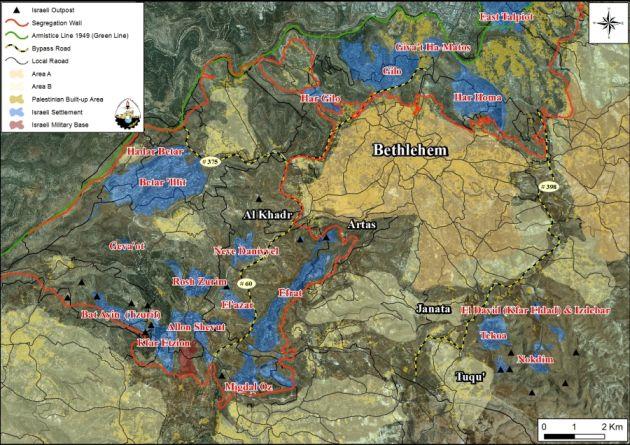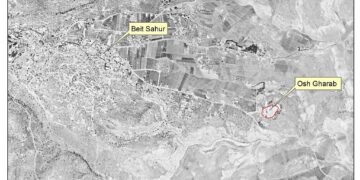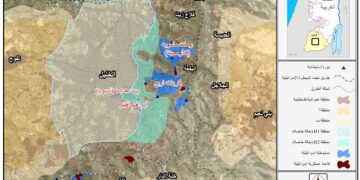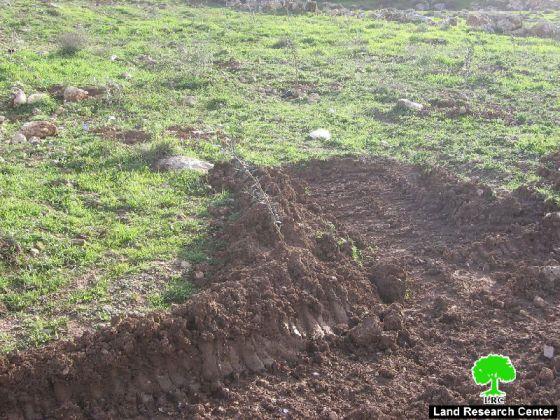On January 31st, 2013, the ‘Israel National News’ agency published on its website that the Israeli defense minister, Ehud Barak, approved the expansion of Tekoa and Nokdim settlements in the West Bank, located southeast of Bethlehem City. The minister gave the green light to advance the planning and building process for another 346 housing units in the aforementioned settlements, where 200 housing units to be built in Tekoa settlements and 146 more to be built in Nokdim settlement in the eastern part of Gush Etzion Bloc.
Few days later, on the 5th of February 2013, the Israeli daily newspaper Yedioth Ahranoth published on its website that the Israeli housing and Construction Ministry issued tenders for the construction of 41 housing units and a Shopping Mall in the Gush Etzion settlement of Efrat, southwest of Bethlehem city.
A glance about Tekoa, Nokdim, and Efrat settlements
The three Israeli settlements of Tekoa, Nokdim and Efrat were established over lands confiscated from Palestinian villages in the Bethlehem Governorate. Below is a brief description of each of the settlements.
Tekoa
It was established on lands of Tequ’ village in the southeastern part of Bethlehem city in 1997. The settlement houses a total population of around 1600 Israeli settlers and occupies a total land area of 1070 dunums
Nokdim
It was established on lands of Tequ’ and Janata villages in the southeastern part of Bethlehem city in 1982. The settlement houses a total population of around 1300 Israeli settlers and occupies a total land area of 408 dunums.
Efrat
It was established in 1979 on lands confiscated from Al Khader and Artas villages in the southwestern part of Bethlehem city. The settlement houses a total population of 8300 Israeli settlers and occupies a total land area of 2180 dunums. Table No.1 gives more details of the three Illegal settlements. Table 1
Table 1: Details of Tekoa, Nokdim and Efrat settlements in Bethlehem Governorate |
No. |
Settlement Name
|
Establishment
date |
Area (Dunums) |
Population
2009 |
1 |
Tekoa
|
1977 |
1,070 |
1,596 |
2 |
Nokdim |
1982 |
408 |
1,308 |
3 |
Efrat |
1979 |
2,180 |
8,300 |
Total |
|
3,658 |
11,204 |
Source |
Gush Etzion Regional Council (2009) |
Reasons and Implications of the expansion of the illegal settlements (Tekoa, Nokdim and Efrat)
During the past two decades, and most specifically, following the upgrading of Palestine’s statues to a non-member observer state by the United Nation, Israel has boosted up settlements construction in the occupied Palestinian territory in general and moved forward to revive many settlement plans that were halted for years due to international criticism.
The expansion of Tekoa and Nokdim settlements and the Israeli attempt to connect them with Gush Etzion bloc[1] comes within the framework of imposing facts on the ground at the expanse of the Palestinians communities before it starts.
Israel also envisions a territorial contiguity between settlement blocs[2] in the West Bank and Israeli settlements located inside these blocs so that it annexes the largest number of Israeli settlements in the West Bank to its proper upon the completion of its plans in the area and with particular focus on Jerusalem. This accomplished through the construction of the Israeli Segregation Wall which will annex the three major settlement blocs surrounding Jerusalem (Ma’ale Adumim, Giv’at Zeev and Gush Etzion) and linking these blocs with the Israeli settlements that are of strategic importance to Israel in terms of their geographical location, population and type, as in the case of Tekoa and Nokdim settlements and how Israel is striving to connect them with the Gush Etzion settlement bloc.
To Conclude
Israel’s continuous policy of confiscating Palestinian lands for the construction and expansion of Israeli settlements kills any chance for a future and contiguous Palestinian state and contradicts with international law, Human Rights conventions and United Nation resolutions such as:
Moreover United Nations Security Council, Resolution 446 March 22, 1979 calls on Israel to rescind its previous measures and to desist from taking any action which would result in changing the legal status and geographical nature and materially affecting the demographic composition of the Arab territories occupied since 1967, including Jerusalem and, in particular, not to transfer parts of its own civilian population into the occupied Arab territories’.
Also the resolution 452 of the 1979 “calls upon the Government and people of Israel to cease, on an urgent basis, the establishment, construction and planning of settlements in the Arab territories occupied since 1967, including Jerusalem.
In May 2001, the head of the International Red Cross delegation to Israel and the Occupied Territories said that settlements are ‘equal in principle to war crimes’. (Note: ‘The transfer, the installation of population of the occupying power into the occupied territories is considered as an illegal move and qualified as a ‘grave breach.’ It’s a grave breach, formally speaking, but grave breaches are equal in principle to war crimes’, Rene Kosirnik, head of the ICRC delegation to Israel and the OPT, press conference 17 May 2001.)
[1] Which the settlement of Efrat is part of it and received approval for the construction of new housing units.
[2] The major Israeli settlement blocs in the West Bank Territory are: Ma’ale Adumim settlement bloc (East of Jerusalem ), Giv’at Zeev settlement bloc (northwest of Jerusalem), Gush Etzion settlement bloc (south of Jerusalem), Modi’in Illit settlement bloc (West of Ramallah ), Ariel settlement bloc (North of Salfit) and Kiryat Arba’ settlement bloc (south of Hebron).















